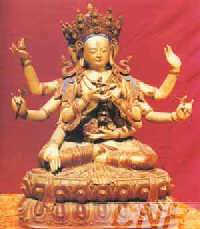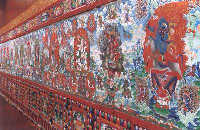|

Sculpture:Sculpture, which holds an important position among Regong art, mainly includes clay sculpture, woodcarving, brick engraving and so on, where clay sculpture is the most popular. The art of clay sculptures had matured from the mid-17th century to the early 19th century when the sculptures were exquisitely carved and were lifelike, with smooth clothing lines, a sense of reality and a strong contrast in colors that were arranged harmoniously.
The clay sculptures in Regong were combined with temple architecture to express the wide-ranging contents related to the architecture. The range of subjects is also very wide. Besides the sun, moon and stars, mountains, flowers and trees, birds, beasts, fishes and worms and other patterns used as decorations and foils, different colors and other various images also appear in sculptures. These include the bizarre motley Buddhist guardians, Buddha's warrior attendants with horrifying features, horse-headed and red-haired gods, and so on.
In addition, woodcarving and brick engraving can also be found in many places. Woodcarving is mainly employed to make decorative patterns on door lintels and chapiters of a house, as well as wooden josses. Brick carving is mainly seen in such forms of architecture, as decorative patterns,dragons and phoenixes and pairs of lions on the ridge of a house, beasts on flying roofs and basso reliefs on walls.

"Magnificent Spectacle of Color Paintings About Chinese Tibetan Culture and Arts":Planned and designed by famous painter Zongzhe Lajie and jointly painted by about 400 artists, this hugescroll paintingwas completed in August 1999 after four years of painstaking efforts.
With a length of 618 meters and a width of 2.5 meters, it is the longest painting scroll in the world. The whole scroll covers more than 1,500 square meters and weighs over 1,000 kilograms. Its contents involve the history, culture, folk customs and arts of the Tibetan ethnic minority, including the formation of the world, the origin of the Tibetan ethnic minority, past Tibetan kings, the story of Sakyamuni, different sects of Tibetan Buddhism, historical celebrities, medicine, astronomy, literature, architecture, as well as scenic spots and historical sites in Tibet, festival scenes, costumes, articles for daily use, weapons, decorative patterns, and so on. Thus, it can be regarded as the encyclopedia of Tibetan history and culture.
|



